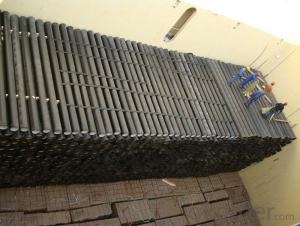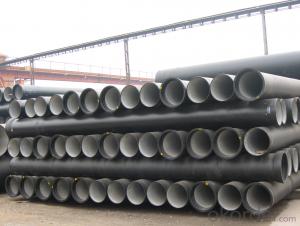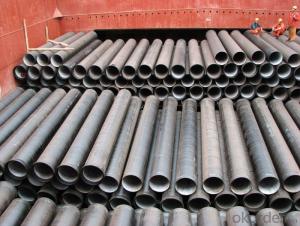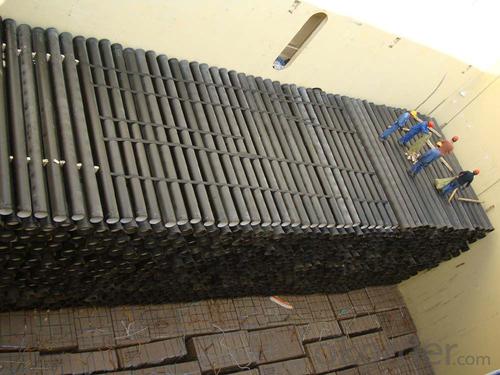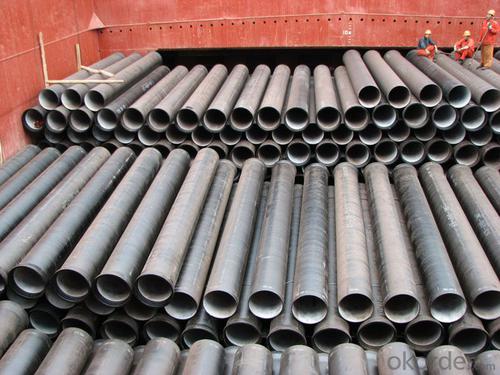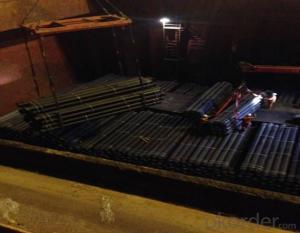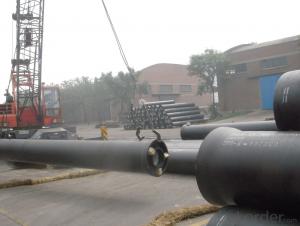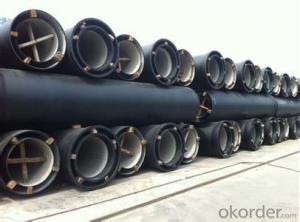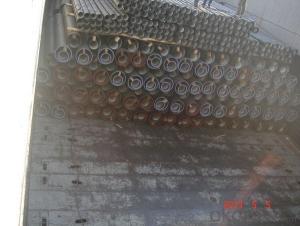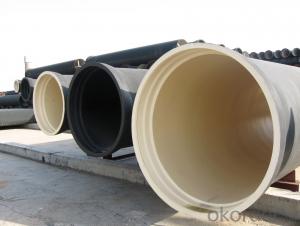DUCTILE IRON PIPE DN500 K8
- Loading Port:
- China Main Port
- Payment Terms:
- TT OR LC
- Min Order Qty:
- -
- Supply Capability:
- -
OKorder Service Pledge
OKorder Financial Service
You Might Also Like
Specification:
1) The standard of pipe: ISO2531:1998, K9
2) Effective length: 6m
3) Inner cement line: Portland cement line as per ISO4179
4) Zinc coating: at least 130g/m2 as per ISO8179
5) Bitumen painting: at least 70um as per ISO8179
6) With 100% quantity of NBR ring, or SBR ring, or EPDM ring as per ISO4633
7) DN80mm-800mm
8) High strength, lighter than grey iron, good corrosion resistance, no furring, small flow resistance, easy fixing, long life tome about 100 yeas
9) Produced by Hangzhou chunfeng machine
10) Checked by automatic inspection equipment
11) Composition:
Chemical composition | | | | |||
Chemical composition | Ductile Cast Iron Pipe (%) | Grey iron pipe (%) | Steel pipe (%) | | | |
C | 3.5-4.0 | 3.2-3.8 | 0.1-0.2 | | | |
Si | 1.9-2.6 | 1.4-2.2 | 0.15-0.4 | | | |
Mn | 0.15-0.45 | 0.4-0.6 | 0.3-0.6 | | | |
P | ≤0.06 | ≤0.3 | 0.02-0.03 | | | |
S | ≤0.02 | ≤0.1 | 0.02-0.03 | | | |
Mg | 0.03-0.06 |
|
| | | |
12) Feature:
Mechanical properties | | | | |||
| Ductile Cast Iron Pipe | Grey Iron Pipe | Steel Pipe | | | |
Tensile Strength(Mpa) | ≥420 | 150-260 | ≥400 | | | |
Yield Strength(Mpa) | ≥300 | No Confirmation | No Confirmation | | | |
Bending Strength(Mpa) | ≥590 | 200-360 | ≥400 | | | |
Elongation (%) | ≥10 | Neglected | ≥18 | | | |
Brinell Hardness(HBS) | ≤230 | ≤230 | About 140 | | | |
13) T type mechanical joint
14) Packing: in bulk or container
- Q: Can ductile iron pipes be used for mining applications?
- Yes, ductile iron pipes can be used for mining applications. Ductile iron pipes are known for their strength, durability, and resistance to corrosion, making them suitable for various industrial purposes, including mining. Their ability to withstand high pressure and handle heavy loads makes them ideal for transporting water, slurry, and other materials commonly used in mining operations. Additionally, ductile iron pipes have a long lifespan, reducing the need for frequent replacements and maintenance in mining environments.
- Q: What is the relationship between continuous cast iron pipe and ductile iron pipe?
- In general, the continuous cast iron pipe is the continuous casting of gray cast iron pipe, while the centrifugal cast iron pipe is centrifugal ductile iron pipe. Of course, you have to be hard, just to make continuous ductile iron pipes, that's what you want.
- Q: Can ductile iron pipe be used for water treatment plants?
- Yes, ductile iron pipe can be used for water treatment plants. Ductile iron pipe is a commonly used material in the water industry due to its strength, durability, and corrosion resistance. It is suitable for various applications, including transporting water in water treatment plants. Ductile iron pipe can withstand high pressure and is well-suited for underground installations. It also has excellent resistance to corrosion from water and chemicals commonly used in water treatment processes. Additionally, ductile iron pipe is easy to install and maintain, making it a preferred choice for water treatment plants. Overall, ductile iron pipe is a reliable and cost-effective option for water transport in water treatment plants.
- Q: What is the expected buoyancy of ductile iron pipes?
- Several factors, including diameter, wall thickness, and fluid specific gravity, can influence the expected buoyancy of ductile iron pipes. However, in general, ductile iron pipes are recognized for their relatively low buoyancy compared to materials like plastic or concrete. Ductile iron pipes possess a higher density and weight, resulting in a greater resistance to buoyancy forces. This quality makes them suitable for applications where buoyancy is a concern, such as water and wastewater transmission systems. Their inherent strength and weight combination ensures that the pipes stay grounded and do not float or rise to the surface. It is important to acknowledge that despite the lower buoyancy of ductile iron pipes compared to other materials, there may still be some level of buoyancy in certain scenarios, particularly when the fluid being transported has a lower specific gravity. To address this potential issue, measures like anchoring or ballasting can be employed to guarantee the stability and integrity of the pipeline system. In conclusion, while the expected buoyancy of ductile iron pipes is generally low, it is crucial to consider the specific conditions and requirements of the project to determine the most suitable pipe material and design for optimal performance and safety.
- Q: Can ductile iron pipes be used for slurry transportation?
- Yes, ductile iron pipes can be used for slurry transportation. Ductile iron pipes are known for their high strength and durability, making them suitable for various applications including slurry transportation. Slurry is a mixture of solid particles and a liquid, which can be abrasive and corrosive. Ductile iron pipes have excellent resistance to abrasion, corrosion, and erosion, making them capable of handling the challenges posed by slurry transportation. Additionally, ductile iron pipes offer a smooth inner surface, reducing friction and improving the flow of slurry. Therefore, ductile iron pipes are a reliable choice for slurry transportation systems in industries such as mining, wastewater treatment, and oil and gas.
- Q: Can ductile iron pipes be used for cooling water systems?
- Indeed, cooling water systems can utilize ductile iron pipes. Renowned for their resilience, robustness, and resistance to corrosion, ductile iron pipes are a fitting choice for various applications, including cooling water systems. With the ability to withstand high pressure and temperature fluctuations, these pipes excel in circulating and transporting cooling water. Moreover, their smooth interior surface mitigates friction, diminishing the likelihood of scaling or blockages and enabling the efficient flow of cooling water. Consequently, ductile iron pipes emerge as a dependable and efficient option for cooling water systems.
- Q: What are the differences between cast iron pipes W and A?
- Cast iron drainage pipe generally divided into three categories, namely W type socket cast iron pipes, cast iron pipes of A type, B type cast iron drainage pipe, the three pipes have good seismic performance, strong sealing performance, simple construction, convenient maintenance, reliable use, so it is also called the cast iron pipe for earthquake.
- Q: Are ductile iron pipes suitable for use in residential plumbing?
- Yes, ductile iron pipes are suitable for use in residential plumbing. Ductile iron is a strong and durable material that is resistant to corrosion, making it ideal for plumbing systems. It has a high tensile strength, which means it can withstand high pressure and is less likely to crack or break compared to other materials. Ductile iron pipes are also known for their long lifespan, lasting up to 100 years or more, making them a reliable choice for residential plumbing systems. Additionally, ductile iron pipes have excellent flow characteristics, allowing for efficient water distribution throughout the home. Overall, the strength, durability, and corrosion resistance of ductile iron pipes make them a suitable and long-lasting option for residential plumbing.
- Q: What are the different types of valves available for ductile iron pipe?
- Ductile iron pipe offers a variety of valve options, each with its own unique purpose and function. Among the most commonly used valves are: 1. Gate Valves: These valves are designed to either fully open or fully close the fluid flow in the pipe. They feature a gate-like mechanism that permits or blocks the passage of fluid depending on the valve's position. 2. Butterfly Valves: Butterfly valves are quarter-turn valves that utilize a circular disc to control the flow. When open, the disc aligns parallel to the flow, resulting in minimal pressure drop. Conversely, when closed, the disc aligns perpendicular to the flow, effectively stopping the fluid. 3. Ball Valves: Ball valves consist of a spherical disc with a central hole, known as a ball. When the valve is open, the ball is positioned to allow fluid to pass through the hole. To close the valve, the ball is rotated to obstruct the flow. 4. Check Valves: Check valves are specifically designed to permit fluid flow in one direction only, preventing backflow. They incorporate a flap or disc that opens when the flow is in the correct direction and closes to halt the flow when reversal occurs. 5. Plug Valves: Plug valves feature a cylindrical or conical plug with a through-hole that can be rotated to regulate the flow. When open, the hole aligns with the pipe, enabling fluid to pass. Closing the valve positions the hole perpendicular to the pipe, blocking the flow. 6. Pressure Reducing Valves: These valves serve the purpose of controlling and reducing the pressure of fluid within the pipe. They employ a mechanism that adjusts the flow area to achieve pressure reduction. 7. Pressure Sustaining Valves: Pressure sustaining valves are utilized to maintain a specific pressure level within the pipe. They automatically adjust the flow area to sustain the desired pressure. 8. Air Release Valves: Air release valves are employed to eliminate trapped air within the pipe. They allow air to escape while preventing fluid leakage. These examples demonstrate the diverse range of valve options available for ductile iron pipe. The selection of a suitable valve depends on factors such as the application, flow requirements, and desired functionality.
- Q: Can ductile iron pipe be used for stormwater management systems?
- Yes, ductile iron pipe can be used for stormwater management systems. Ductile iron pipe is commonly used in various applications, including stormwater drainage systems. It is known for its strength, durability, and resistance to corrosion, making it ideal for withstanding the harsh conditions of stormwater management. Additionally, ductile iron pipe is easily installed and maintained, making it a cost-effective choice for stormwater management systems. Overall, ductile iron pipe is a reliable and suitable option for constructing stormwater management systems.
Send your message to us
DUCTILE IRON PIPE DN500 K8
- Loading Port:
- China Main Port
- Payment Terms:
- TT OR LC
- Min Order Qty:
- -
- Supply Capability:
- -
OKorder Service Pledge
OKorder Financial Service
Similar products
Hot products
Hot Searches
Related keywords
